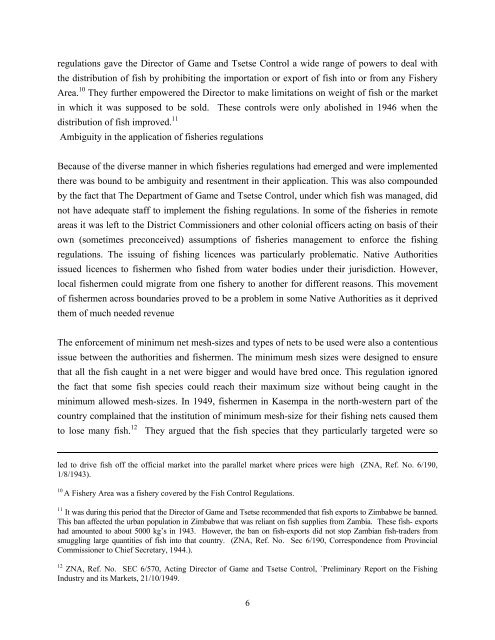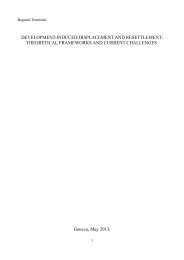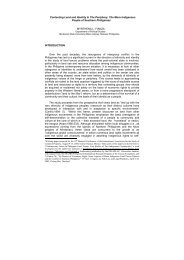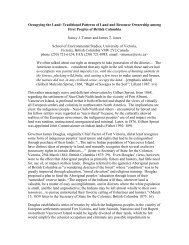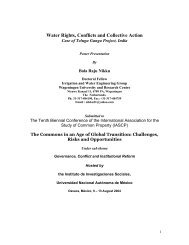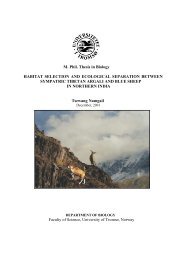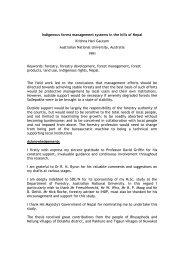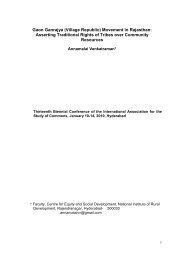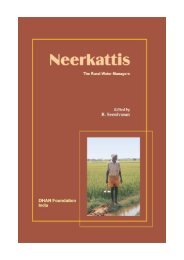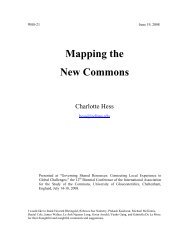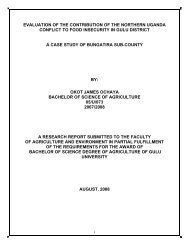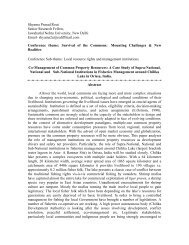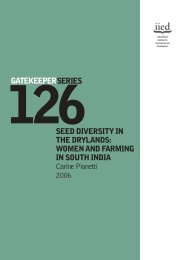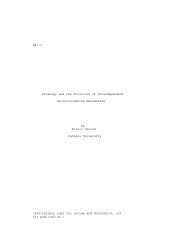The emergence of fisheries legislation and regulations in Zambia ...
The emergence of fisheries legislation and regulations in Zambia ...
The emergence of fisheries legislation and regulations in Zambia ...
Create successful ePaper yourself
Turn your PDF publications into a flip-book with our unique Google optimized e-Paper software.
egulations gave the Director <strong>of</strong> Game <strong>and</strong> Tsetse Control a wide range <strong>of</strong> powers to deal with<br />
the distribution <strong>of</strong> fish by prohibit<strong>in</strong>g the importation or export <strong>of</strong> fish <strong>in</strong>to or from any Fishery<br />
Area. 10 <strong>The</strong>y further empowered the Director to make limitations on weight <strong>of</strong> fish or the market<br />
<strong>in</strong> which it was supposed to be sold. <strong>The</strong>se controls were only abolished <strong>in</strong> 1946 when the<br />
distribution <strong>of</strong> fish improved. 11<br />
Ambiguity <strong>in</strong> the application <strong>of</strong> <strong>fisheries</strong> <strong>regulations</strong><br />
Because <strong>of</strong> the diverse manner <strong>in</strong> which <strong>fisheries</strong> <strong>regulations</strong> had emerged <strong>and</strong> were implemented<br />
there was bound to be ambiguity <strong>and</strong> resentment <strong>in</strong> their application. This was also compounded<br />
by the fact that <strong>The</strong> Department <strong>of</strong> Game <strong>and</strong> Tsetse Control, under which fish was managed, did<br />
not have adequate staff to implement the fish<strong>in</strong>g <strong>regulations</strong>. In some <strong>of</strong> the <strong>fisheries</strong> <strong>in</strong> remote<br />
areas it was left to the District Commissioners <strong>and</strong> other colonial <strong>of</strong>ficers act<strong>in</strong>g on basis <strong>of</strong> their<br />
own (sometimes preconceived) assumptions <strong>of</strong> <strong>fisheries</strong> management to enforce the fish<strong>in</strong>g<br />
<strong>regulations</strong>. <strong>The</strong> issu<strong>in</strong>g <strong>of</strong> fish<strong>in</strong>g licences was particularly problematic. Native Authorities<br />
issued licences to fishermen who fished from water bodies under their jurisdiction. However,<br />
local fishermen could migrate from one fishery to another for different reasons. This movement<br />
<strong>of</strong> fishermen across boundaries proved to be a problem <strong>in</strong> some Native Authorities as it deprived<br />
them <strong>of</strong> much needed revenue<br />
<strong>The</strong> enforcement <strong>of</strong> m<strong>in</strong>imum net mesh-sizes <strong>and</strong> types <strong>of</strong> nets to be used were also a contentious<br />
issue between the authorities <strong>and</strong> fishermen. <strong>The</strong> m<strong>in</strong>imum mesh sizes were designed to ensure<br />
that all the fish caught <strong>in</strong> a net were bigger <strong>and</strong> would have bred once. This regulation ignored<br />
the fact that some fish species could reach their maximum size without be<strong>in</strong>g caught <strong>in</strong> the<br />
m<strong>in</strong>imum allowed mesh-sizes. In 1949, fishermen <strong>in</strong> Kasempa <strong>in</strong> the north-western part <strong>of</strong> the<br />
country compla<strong>in</strong>ed that the <strong>in</strong>stitution <strong>of</strong> m<strong>in</strong>imum mesh-size for their fish<strong>in</strong>g nets caused them<br />
to lose many fish. 12 <strong>The</strong>y argued that the fish species that they particularly targeted were so<br />
led to drive fish <strong>of</strong>f the <strong>of</strong>ficial market <strong>in</strong>to the parallel market where prices were high (ZNA, Ref. No. 6/190,<br />
1/8/1943).<br />
10 A Fishery Area was a fishery covered by the Fish Control Regulations.<br />
11 It was dur<strong>in</strong>g this period that the Director <strong>of</strong> Game <strong>and</strong> Tsetse recommended that fish exports to Zimbabwe be banned.<br />
This ban affected the urban population <strong>in</strong> Zimbabwe that was reliant on fish supplies from <strong>Zambia</strong>. <strong>The</strong>se fish- exports<br />
had amounted to about 5000 kg’s <strong>in</strong> 1943. However, the ban on fish-exports did not stop <strong>Zambia</strong>n fish-traders from<br />
smuggl<strong>in</strong>g large quantities <strong>of</strong> fish <strong>in</strong>to that country. (ZNA, Ref. No. Sec 6/190, Correspondence from Prov<strong>in</strong>cial<br />
Commissioner to Chief Secretary, 1944.).<br />
12 ZNA, Ref. No. SEC 6/570, Act<strong>in</strong>g Director <strong>of</strong> Game <strong>and</strong> Tsetse Control, `Prelim<strong>in</strong>ary Report on the Fish<strong>in</strong>g<br />
Industry <strong>and</strong> its Markets, 21/10/1949.<br />
6


